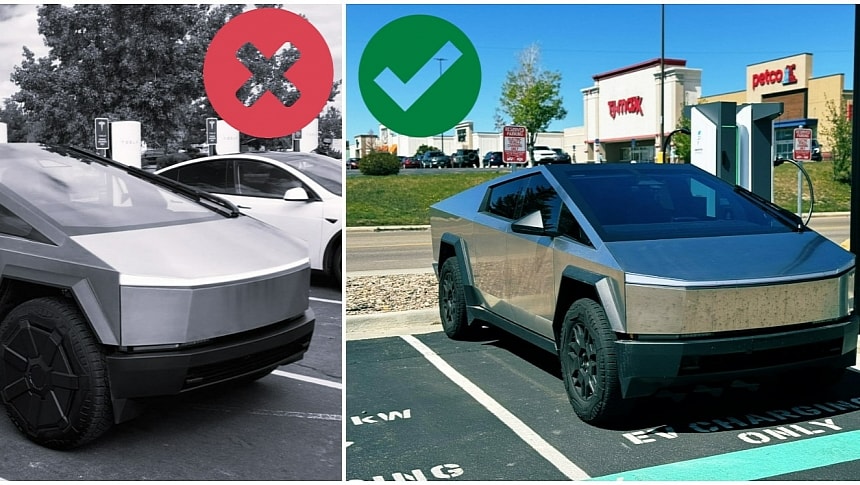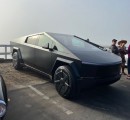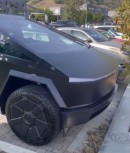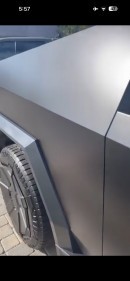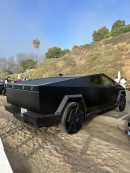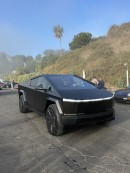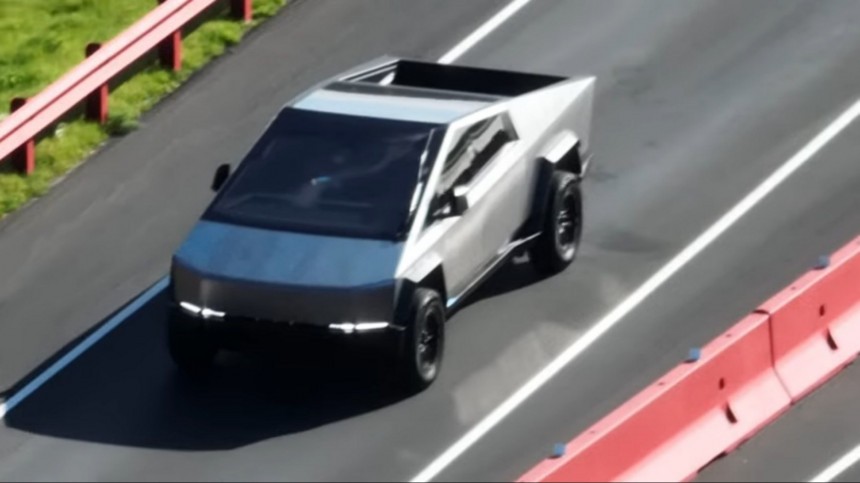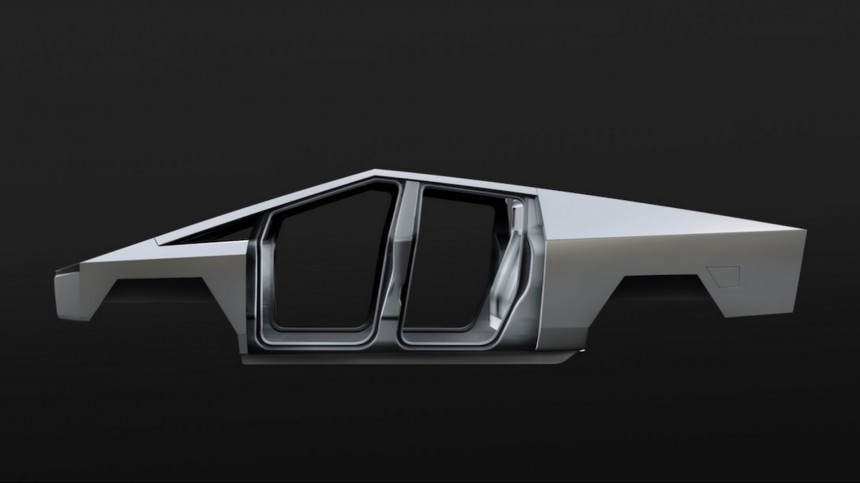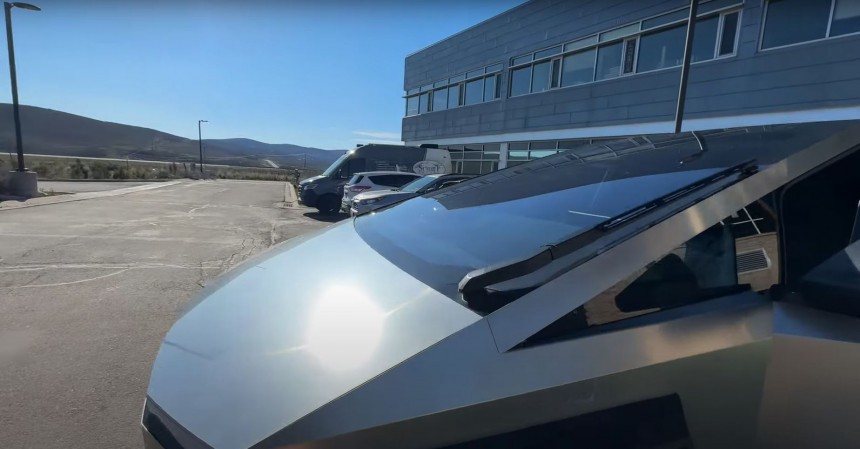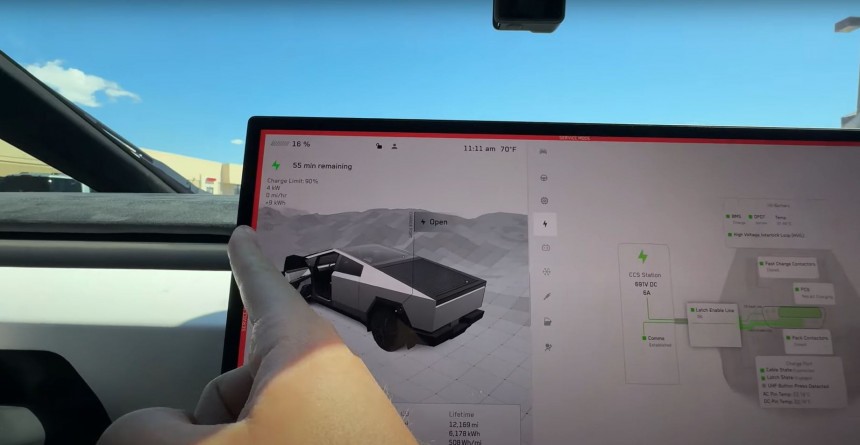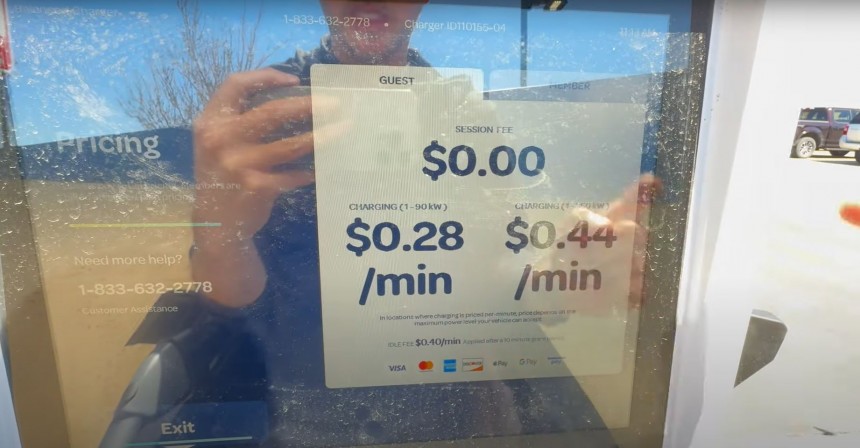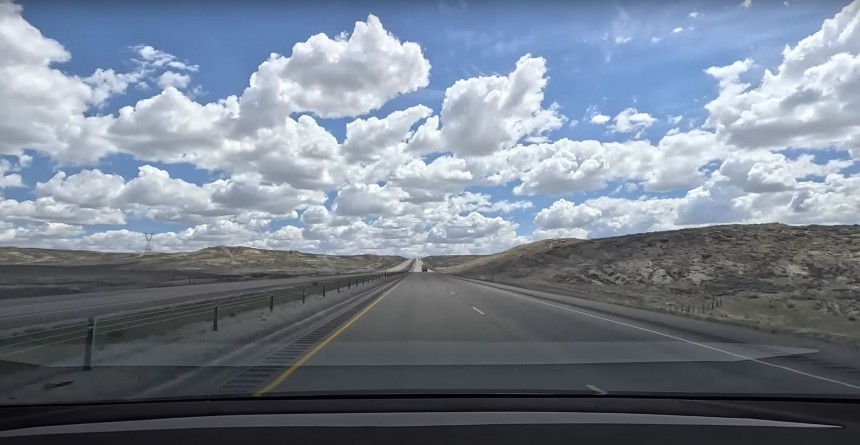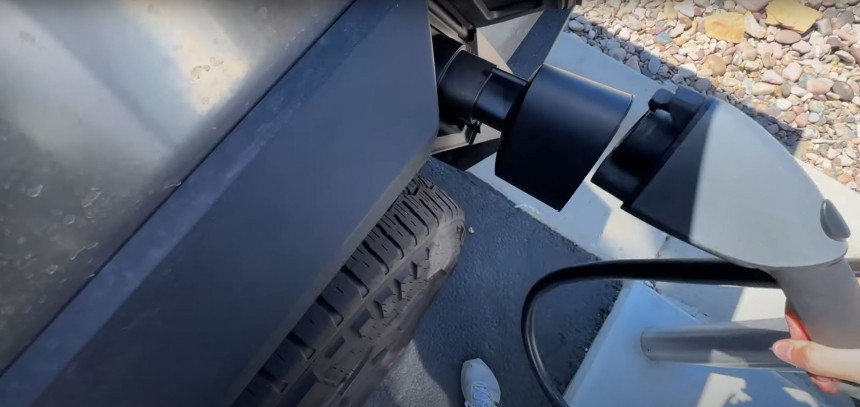While it's common knowledge that the Cybertruck cannot tow the average trailer commonly used in the US for more than 100-110 miles on a full charge, that doesn't mean the all-electric pickup truck can't be used for slightly longer-than-usual journeys or commuting. After all, it is a Tesla. If you end up owning this EV and using it for trailer-free road trips, it may be a good idea to stop at a Supercharger only if it's a must.
As multiple previous real-world tests have proven, towing a 6,500-8,000 lb trailer with the dual- or tri-motor Cybertruck results in a range of 90 to 115 miles (145 to 185 kilometers). Essentially, it more than halves.
But it has been clear for some time now that this EV wasn't envisioned as a workhorse. Tesla created the edgy ride to give people who buy Ford F-150 Lightnings or Rivian R1Ts an alternative. It's a rather pricey option, if we're to be honest. The Chevy Silverado 4WT or RST is a better buy for tradespeople.
However, given the many new technologies (new for the Texas-based automaker, not the entire industry) that Tesla crammed into this pickup truck, there's also a sense of special novelty to it. Some, like this North Carolina man we told you about, are willing to spend an extra $20,000 over MSRP (which only gets them an etch right now) to get their hands on the pointy zero-tailpipe emission ride faster than others who are waiting in line.
Granted, many are also trying to flip them for a profit (if Tesla lets them) or use the unit for a side hustle to generate some extra revenue. And there's nothing wrong with that!
Among the Cybertruck novelties we mentioned earlier, we find the 123-kWh battery pack built on the 800V architecture that's supposed to enable charging speeds in excess of 350 kW. The problem? Tesla doesn't have 350-kW-ready dispensers in North America. It has them in Europe, but the Cybertruck can't be sold on the right side of the pond. V3 Superchargers are limited to an output of 250 kW, which is more than enough for almost all Model 3, Model Y, Model S, and Model X owners who can't charge at home, at work, or at the place they're staying overnight when traveling.
But when you have a larger battery pack to replenish, those 250-kW cabinets start to look pretty dated. It gets even worse when you realize that the Cybertruck doesn't have a great charging curve (i.e., maintaining a high rate of charge). It can go above the 300-kW mark (at non-Supercharger dispensers) for about five minutes. Afterward, it drops to 250 kW and below after reaching a 20 percent state of charge and continues to lose steam as the 4680 "Cybercells" fill up. For example, charging above a 40 percent state of charge happens at around 150 kW or slower.
In theory, going from 10 to 80 percent can take between 40 and 45 minutes when the EV is plugged into a DC fast charger that can dispense power at 350 kW or more. At a Supercharger, you would be looking at five to 10 minutes more.
There's hope, though! Tesla promised to unlock more charging power in a future software update. The brand has done that before with other of its EVs. It intentionally handicapped some of the first iterations to see how they would perform in a real-world scenario and pushed over-the-air changes only after the engineers realized that it would be safe to do so.
They should also unlock Autopilot and FSD sooner rather than later. But until all upgrades are ready for all Cybertrucks, here's what you can expect while road-tripping.
However, the journey was off to a rough start because the previous night, the EV's Gigawiper twisted onto itself somehow and came off its track. The driver had to remove it completely and make sure that the wiper arm wouldn't scratch the rock-proof windshield.
Moreover, the driver, who is accustomed to an EV-only lifestyle, knew that the DC dispensers on his route were old V2 pedestals. Those are even worse than V3 Superchargers because their maximum output is limited to 150 kW. The good news is that Electrify America has some high-power DC fast chargers in the same area. The driver wasn't going to waste any precious time by plugging the Cybertruck into one of the VW-owned company's dispensers.
Keeping up with the flow of traffic on I80 meant driving rather often at speeds of up to 85 mph (137 kph). So, the Cyberbeast wasn't gunning for any efficiency trophy. The EV arrived at the Electrify America station with an eight percent state of charge. It covered 156 mi (249 km) at an average speed of 78 mph (126 kph).
Because the driver used Tesla's Trip Planner, the pickup truck was also able to get the battery at the right temperature to accept as much power as safely possible. Be aware that the feature only works when the navigation is routed to a Supercharger. Had he picked the CCS-equipped Electrify America location from the get-go, the Cyberbeast wouldn't have started to precondition at all, which could have resulted in a poor initial charging performance.
However, because the high-voltage energy storage unit was nice and toasty, the dispenser didn't limit its output. Even better, the charging speed wasn't throttled despite the need for a CCS-to-NACS adapter. The initial rate of charge was over 330 kW! That's what you want to see when venturing throughout the country. It did take him four tries to make it work, though!
The onboard computer showed that the Cyberbeast would have needed 55 minutes to reach a 90 percent state of charge. Sadly, after only a few minutes, the charging speed started oscillating.
That's a known problem with some of Electrify America's dispensers. "Yo-yo" charging can be pretty annoying to witness in person because it can delay your plans. Nobody knows yet if this DC charging anomaly affects the high-voltage battery.
After reaching a 25 percent state of charge, the driver switched to another pedestal, and that one worked correctly. However, at that point, the pickup truck wasn't willing to accept a charging rate of over 300 kW. It was limited to under 250 kW, which was still better than what a V2 Supercharger could have done.
After 26 minutes, the EV reached a 64 percent charge, and the driver was ready to resume the journey. They spent nearly $9.5 for 70 kWh of energy. However, it's worth pointing out that the whole thing would have gone smoother if the first dispenser had worked properly.
At the next charging stop, the driver chose an Electrify America stall once more. This time around, it worked perfectly fine, and he paid $6.2 for nearly 65 kWh of energy. Talk about a sweet deal, eh?
The Cyberbeast driver had to stop one more time for a quick recharge, and he went to a V2 Supercharger where the speed was limited to about 145 kW. That was half of what a 350-kW stall could have pumped into the 4680 cell pack.
While on the last leg of the trip, the driver had to deal with a bit of drizzle. Fortunately, coming up with an emergency fix or replacing the self-destructed Gigawiper wasn't needed.
Well, it's now more understandable why battery-electric cars represent under one percent of all passenger rides registered in the US and why hybrid popularity is on the rise. Imagine putting someone who has only driven conventional vehicles all their life behind the Cyberbeast's steering wheel and telling them that they must go on a 400-something-mile trip. They'd have a hard time figuring everything out, including how to save time by picking the correct fast-charging station.
Then, there's the infrastructure. The dispensers that are currently online may or may not work correctly. Depending on your EV of choice, an adapter might be needed. Similarly, you might need an app to know if the charging station is full or not. At the same time, if many people charge at the same time at that location, dispensers may limit individual charging speed to satisfy the energy needs of everyone who's plugged in.
In addition, no matter if your EV is capable of charging very fast or not, it must be able to accept energy at that high rate for longer than five minutes. Otherwise, it makes no difference whether your ride's battery is built on the 400V or 800V architecture.
But the worst thing about road-tripping with an EV is that spending over half an hour plugged in is almost guaranteed to happen more often than you'd want. You can't just fill up in five minutes and be on your way.
Moreover, in states like Wyoming, DC fast charging remains affordable because the user is charged on a per-minute basis. Switching to a per-kWh billing process makes green road-tripping much more expensive. Exclusively using high-power dispensers is even more pricey than paying for gas.
But does all this mean "EVs bad?" No. If you own a home or live in a flat where you're provided access to Level 2 charging, almost any battery-powered vehicle can become a great commuting appliance. Even the opportunity to plug into a domestic socket would do it.
You should be mindful of insurance rates in your area, though. Other than that, something like the Chevy Equinox can easily become a great family vehicle. And you'd do your part in tackling global warming.
What the trip proved is that we're still in the early stages of EV adoption. It will probably be a few years before buying an EV becomes the obvious choice for most Americans looking for a new ride.
But it has been clear for some time now that this EV wasn't envisioned as a workhorse. Tesla created the edgy ride to give people who buy Ford F-150 Lightnings or Rivian R1Ts an alternative. It's a rather pricey option, if we're to be honest. The Chevy Silverado 4WT or RST is a better buy for tradespeople.
However, given the many new technologies (new for the Texas-based automaker, not the entire industry) that Tesla crammed into this pickup truck, there's also a sense of special novelty to it. Some, like this North Carolina man we told you about, are willing to spend an extra $20,000 over MSRP (which only gets them an etch right now) to get their hands on the pointy zero-tailpipe emission ride faster than others who are waiting in line.
Granted, many are also trying to flip them for a profit (if Tesla lets them) or use the unit for a side hustle to generate some extra revenue. And there's nothing wrong with that!
An unfortunate start for a promising machine "from the future"
Sadly, the Cybertruck isn't on a path to greatness. It won't become a collectible anytime soon, and the novelty factor is slowly but surely starting to wear off. The depreciation is already here, and the downtrend will only continue to accentuate because the brand is gradually running out of buyers who are ready to splurge $20,000 just to cut in line and maybe receive some extras at some point.But when you have a larger battery pack to replenish, those 250-kW cabinets start to look pretty dated. It gets even worse when you realize that the Cybertruck doesn't have a great charging curve (i.e., maintaining a high rate of charge). It can go above the 300-kW mark (at non-Supercharger dispensers) for about five minutes. Afterward, it drops to 250 kW and below after reaching a 20 percent state of charge and continues to lose steam as the 4680 "Cybercells" fill up. For example, charging above a 40 percent state of charge happens at around 150 kW or slower.
In theory, going from 10 to 80 percent can take between 40 and 45 minutes when the EV is plugged into a DC fast charger that can dispense power at 350 kW or more. At a Supercharger, you would be looking at five to 10 minutes more.
There's hope, though! Tesla promised to unlock more charging power in a future software update. The brand has done that before with other of its EVs. It intentionally handicapped some of the first iterations to see how they would perform in a real-world scenario and pushed over-the-air changes only after the engineers realized that it would be safe to do so.
Reality is often disappointing
A member of the Out of Spec team recently used a tri-motor Cyberbeast with about 12,000 miles (19,312 kilometers) on the odometer for a trip to Fort Collins, Colorado. They started the journey with 77 percent left in the "tank." Thanks to the automaker's nifty Trip Planner tool, they learned early that a 420-mile (676-kilometer) trip would require two charging stops in Wyoming.However, the journey was off to a rough start because the previous night, the EV's Gigawiper twisted onto itself somehow and came off its track. The driver had to remove it completely and make sure that the wiper arm wouldn't scratch the rock-proof windshield.
Keeping up with the flow of traffic on I80 meant driving rather often at speeds of up to 85 mph (137 kph). So, the Cyberbeast wasn't gunning for any efficiency trophy. The EV arrived at the Electrify America station with an eight percent state of charge. It covered 156 mi (249 km) at an average speed of 78 mph (126 kph).
Because the driver used Tesla's Trip Planner, the pickup truck was also able to get the battery at the right temperature to accept as much power as safely possible. Be aware that the feature only works when the navigation is routed to a Supercharger. Had he picked the CCS-equipped Electrify America location from the get-go, the Cyberbeast wouldn't have started to precondition at all, which could have resulted in a poor initial charging performance.
However, because the high-voltage energy storage unit was nice and toasty, the dispenser didn't limit its output. Even better, the charging speed wasn't throttled despite the need for a CCS-to-NACS adapter. The initial rate of charge was over 330 kW! That's what you want to see when venturing throughout the country. It did take him four tries to make it work, though!
That's a known problem with some of Electrify America's dispensers. "Yo-yo" charging can be pretty annoying to witness in person because it can delay your plans. Nobody knows yet if this DC charging anomaly affects the high-voltage battery.
Stuck between a rock and a hard place
V2 Superchargers would have underperformed, while the Electrify America pedestal didn't work properly. However, one good thing is that the VW-owned company billed his session on a per-minute basis. Paying $0.44 per minute is much more economical than paying for each kWh of power when charging at over 300 kW.After reaching a 25 percent state of charge, the driver switched to another pedestal, and that one worked correctly. However, at that point, the pickup truck wasn't willing to accept a charging rate of over 300 kW. It was limited to under 250 kW, which was still better than what a V2 Supercharger could have done.
After 26 minutes, the EV reached a 64 percent charge, and the driver was ready to resume the journey. They spent nearly $9.5 for 70 kWh of energy. However, it's worth pointing out that the whole thing would have gone smoother if the first dispenser had worked properly.
The Cyberbeast driver had to stop one more time for a quick recharge, and he went to a V2 Supercharger where the speed was limited to about 145 kW. That was half of what a 350-kW stall could have pumped into the 4680 cell pack.
While on the last leg of the trip, the driver had to deal with a bit of drizzle. Fortunately, coming up with an emergency fix or replacing the self-destructed Gigawiper wasn't needed.
Enjoying a free lesson
So, what does this person's trip with the Tesla Cyberbeast teach us?Then, there's the infrastructure. The dispensers that are currently online may or may not work correctly. Depending on your EV of choice, an adapter might be needed. Similarly, you might need an app to know if the charging station is full or not. At the same time, if many people charge at the same time at that location, dispensers may limit individual charging speed to satisfy the energy needs of everyone who's plugged in.
In addition, no matter if your EV is capable of charging very fast or not, it must be able to accept energy at that high rate for longer than five minutes. Otherwise, it makes no difference whether your ride's battery is built on the 400V or 800V architecture.
But the worst thing about road-tripping with an EV is that spending over half an hour plugged in is almost guaranteed to happen more often than you'd want. You can't just fill up in five minutes and be on your way.
Hitting rock bottom can be a good thing. The only way left is up
This journey also confirmed that the Cybertruck, even in its most expensive and capable form as Cyberbeast, is not a finished product. People waited over four years to get their hands on the triangle on wheels, and what they got was a testbed for new tech that may or may not work properly or be as good as the hype before the official November 2023 launch indicated.But does all this mean "EVs bad?" No. If you own a home or live in a flat where you're provided access to Level 2 charging, almost any battery-powered vehicle can become a great commuting appliance. Even the opportunity to plug into a domestic socket would do it.
You should be mindful of insurance rates in your area, though. Other than that, something like the Chevy Equinox can easily become a great family vehicle. And you'd do your part in tackling global warming.
What the trip proved is that we're still in the early stages of EV adoption. It will probably be a few years before buying an EV becomes the obvious choice for most Americans looking for a new ride.
